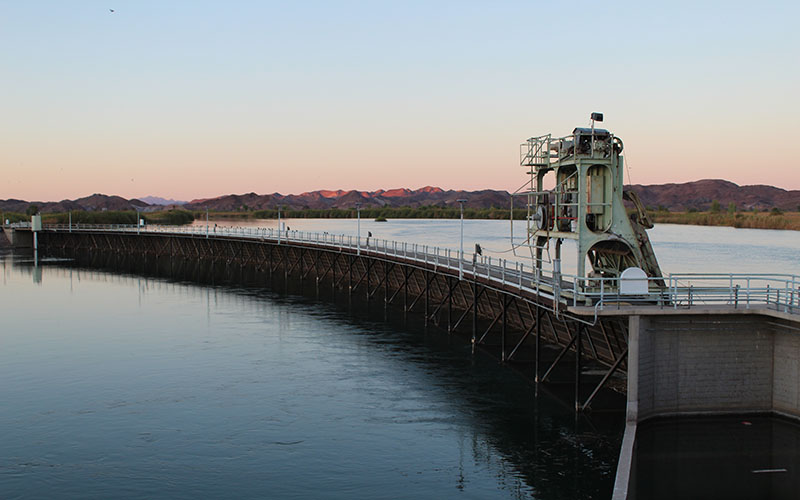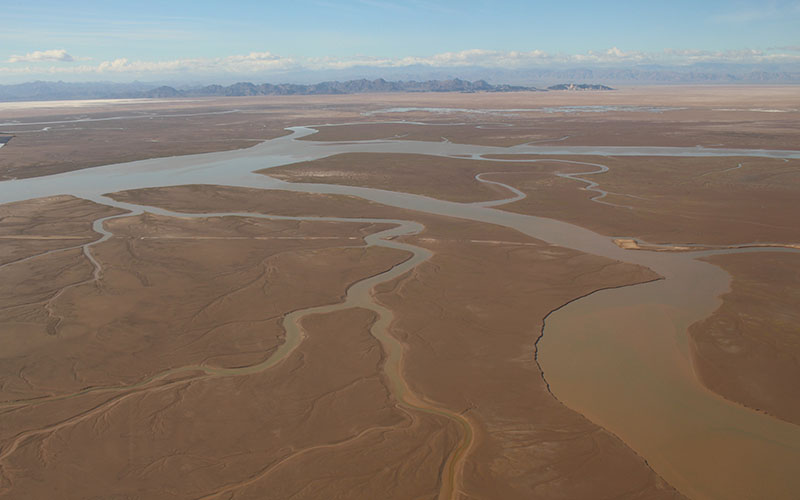SAN LUIS RIO COLORADO, Mexico – From above, tracing the Colorado River along the Arizona-California line in an airplane, it’s easy to see how it happened.
As the river bends and weaves through the Southwest, its contents are slowly drained away. Concrete canals send water to millions of people in Phoenix and Tucson, Los Angeles and San Diego. Farms, ribbons of green contrasted against the desert’s shades of brown, line the waterway.
Farther downstream, near Yuma, the river splits into threads, like a frayed piece of yarn.
A massive multistate plumbing system sends river water to irrigate the hundreds of thousands of farm acres in Southern California and Arizona, hubs for winter vegetables, alfalfa, cotton and cattle.
When the Colorado hits the final dam, on the U.S.-Mexico border, nearly every drop has been claimed. In a typical year, what’s left of the river’s flow – promised to Mexico in a 75-year-old treaty – is sent to farm fields in the Mexicali Valley and the cities of Tijuana, Mexicali and Tecate.
This reliance on an overallocated river has left the Colorado’s final hundred miles as the ultimate collateral damage. Since the early 1960s, when Glen Canyon Dam impounded the river near Page, it has rarely reached the Gulf of California. The thread is frayed beyond recognition, leaving no water for the river itself.
“About 90 percent of the water is retained on the U.S. side and it’s used and diverted,” said Karl Flessa, a researcher at the University of Arizona who studies the Colorado River Delta.
“In effect, one of the things we’ve done historically – not meaning to, especially – what we’ve done is export some of the environmental consequences of water diversions,” he said. “We’ve exported them to Mexico.”
The Colorado River’s inability to complete its journey from the Rocky Mountains to the Gulf of California (also called the Sea of Cortez) has become one of its defining characteristics. Its historic delta, once a haven for birds and mammals in the Sonoran Desert, is a shell of its former self.
From the air, in a flight arranged by the nonprofit group LightHawk, the delta transitions from a jigsaw of farms to a staggering sprawl of muddy salt flats. (LightHawk receives funding from the Walton Family Foundation, which also funds KUNC’s Colorado River coverage.) The river’s historic channel in most parts through Mexico is nothing more than a sandy bed, dotted with tamarisk.
Where the river used to meet the sea, tidal pools and drainages carve the sand and soil into organic patterns, like the cross-section of a lung.
Within the past 12 years, both the U.S. and Mexico have acknowledged the delta’s problems, signing agreements to commit both water and funds to restoring it to some semblance of its former self.
The splashiest of those efforts took place five years ago this spring, and left a lasting imprint on those who witnessed it.

Imperial Dam near Yuma diverts much of the Colorado River to irrigate crops in California’s Imperial and Coachella valleys. (Luke Runyon/KUNC)
The pulse flow
About 8 a.m. on a Sunday in March 2014, water began spilling through Morelos Dam on the U.S.-Mexico border. The release was a culmination of years of negotiation between the U.S., Mexico and environmental organizations.
It was known as the pulse flow – el flujo pulso in Spanish.
“You think of it as this wall of water that’s going to come down, but really it was this creeping tongue of water across the sand,” said Jennifer Pitt, who worked for the Environmental Defense Fund at the time and now directs the Colorado River program for the National Audubon Society. (Both groups receive Walton Family Foundation funding.) Pitt was a key negotiator to make the pulse flow possible.
She spoke while standing in the sandy riverbed below a bridge that leads into the border city of San Luis Rio Colorado. The bridge is at a nexus. The riverbed forms the border of the Mexican states of Sonora and Baja California. Metal barriers form the border between the U.S. and Mexico here, too.
It took a few days after the dam opened for the water to arrive under the bridge, where Pitt and her colleagues had gathered to wait. About 70 people in lawn chairs sat in anticipation. A community cleanup a few days earlier had scrubbed the riverbed of trash.
For many young people, it was the first time they had ever seen water flowing in this stretch of the Colorado. For older residents, it had been decades since they saw this much water here.
“They started getting up just one by one, people coming over to the water and getting down on their hands and knees and just touching it,” Pitt said. “It was like the arrival. The great arrival of the river.”
A spontaneous festival started, complete with music, food vendors, horses and boats.
“I’ve spent 20 years thinking about how we can restore the Colorado River from where it dries out to where it reaches the sea,” Pitt said, “and in all of that thinking have never imagined that this site could bring so many people in as a magnet for people to enjoy something.”
Within weeks, the flow was soaked up by depleted soils, though it did eventually reach the Gulf of California. From where Pitt and I are standing at the bridge in early December 2018, you’d never know the West’s mightiest river was supposed to flow here.
The pulse flow was about 105,000 acre-feet of water, enough to again turn the channel into a river for a few weeks. One acre-foot generally provides enough water for two average American households for a year. Historically, more than 12 million acre-feet flowed into the delta each year.
The agreement that allowed for the pulse flow, called Minute 319, also provided for about 57,000 acre-feet of water to be delivered to specific restoration sites after the pulse flow.
Combined, that amount of water led to a greening of the river corridor, and sustained more than 275,000 new trees, according to a December 2018 report from the International Boundary and Water Commission, which applies the boundary and water treaties of the United States and Mexico and settles differences that may arise in their application.
The pulse flow’s biggest effects were short-lived. A study from U.S. Geological Survey scientists found that the flow was too small to change the channel in a significant way or scrub the riverbed, which would’ve happened during a more natural spring flood when flows would be much higher.
Because of the delta’s low water table, a lot of river water seeped into the ground before it could do any good on the surface to help establish new wildlife habitat in expanded restoration areas.
Fleesa, the UA researcher, said scientists experiment all the time, chart the results and move on.
Does he think the delta will ever see another pulse flow on the scale and magnitude of the one seen in 2014?
“Probably not,” he said. “Because you can get the water to do more restoration work by delivering it in smaller doses, as it were, and delivering it to the right places where the vegetation can really take advantage of it.
“I think restoration, like any other activity with water, we’re really obliged as a society to be as water efficient as possible.”
‘A part of you has come back’
Pitt, with the Audubon Society, said the pulse flow’s greatest lasting effect might have been its ability to unlock people’s imaginations. Those who live nearby could see water in the channel, and that lingered in their memory, even after the flow was finished. Soon after, conservation groups started harnessing that imagination to get communities to buy into the idea that the delta can be partly restored.
Crisoforo Arcos, who witnessed the flow from his small community of Miguel Aleman, now works at a river restoration site. At 63, he remembers fishing in the river as a boy in the early 1960s.
Before the pulse flow, Arcos could only tell stories of what the Colorado used to look like.
“There was the time here everyone in the community, the people of San Luis Rio Colorado, came to the river to enjoy themselves,” Arcos said through a translator. “But it was a very low level of water, very, very little. This was years ago, and since then we haven’t seen any water.”
The pulse flow also inspired art. That was on display one night in late 2018 at La Liberia, a bookstore in downtown San Luis. One by one, writers stood at the front of the room and read their work. Much of it focused on the writer’s relationship to the river.
After the event, local architect Nancy Saldana stood outside on the sidewalk. She was born in San Luis, and considers herself a community activist. In the yellow glow of the street lights, she recalled the pulse flow.
“The day it arrived was something like you feel that a part of you has come back,” she said through a translator. “I think it’s like when you lose something, in your gut, something inside you. That for us is the water.”
Those eight weeks of water were a spectacle in her hometown, Saldana said. There are ongoing talks and a master plan in place for the city to create a riverfront park. But the city is still working on finding enough water to run through the channel on a regular basis. As more time passes, there’s a chance that those who witnessed the pulse flow will begin to forget how they felt.
“Our parents always have the memory of the river with water,” Saldana said. “But new people, people who’ve never been in contact with the water, like kids and people who weren’t there, there is a risk that they don’t feel this connection, that they don’t feel the connection with this river if they’ve never lived it.
“I don’t believe that if there hadn’t been the pulse flow, I don’t think we would have felt as much hope.”
Hope, she said, in the radical idea that rivers can – and should – have water.
This story is part of a series on the Colorado River delta, and part of an ongoing project covering the Colorado River watershed, produced by KUNC and supported through a Walton Family Foundation grant. KUNC is solely responsible for its editorial content.
This story is part of Elemental: Covering Sustainability, a new multimedia collaboration between Cronkite News, Arizona PBS, KJZZ, KPCC, Rocky Mountain PBS and PBS SoCal.
AlertMe

